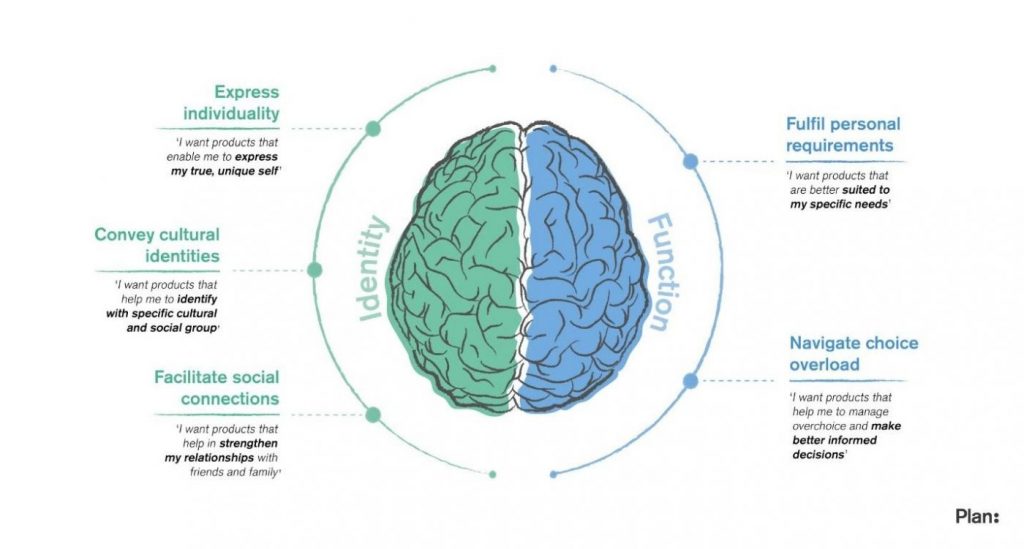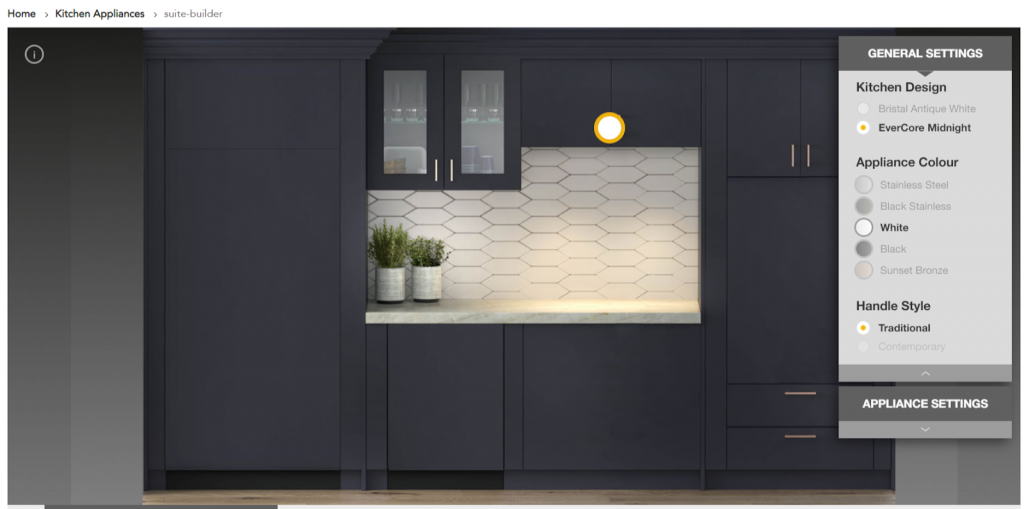Looking ahead to the 2025 holiday season — the biggest sales of the year — many brands start thinking about offering a personalized shopping experience for their customers to maximize sales. That’s a smart move because the sooner you prepare your holiday marketing campaigns, the higher chance you’ll achieve great success.
To help you get ready with 2025 holiday sales, we walk you through two effective marketing strategies that can make your customers’ holiday shopping personal, including gift finders and product configurators.
Let’s dive in.
Use AI-Conversational Gift Finders to Drive Holiday Sales
What Is a Gift Finder?
A gift finder (also called a gift guide) is designed to help shoppers find gifts that meet their expectations and needs.
When customers use a product finder, they’ll be asked a few questions about what they’re looking for. Once the customer completes the questions, they’ll get gift recommendations relevant to their answers.
Here’s the Pandora Gift Finder:

When you click Start, you’ll see the following dialog asking you four multiple-choice questions: “who are you shopping for?” “What are you celebrating?” “What is your budget?” and “What type of jewelry are you looking for?”

Click View Results, and you’ll get a lot of gift ideas recommended based on your answers:

It’s interesting to note that Pandora even takes advantage of urgency marketing to give customers a little push to take action. They display the text “Last chance sale – shop now” and a countdown timer right above product recommendations, which is good to draw attention.
Benefits of Using Gift Finders
1. Personalize Gifts
According to NRF, an American spent $650 on gifts for family, friends, and co-workers on average during the 2020 holiday season. When shopping, they don’t just pick random gifts but take a lot of time finding unique, special gifts that can make a lasting impression for those they’ll give the gifts.
Google data revealed that mobile searches for “personalized gifts” have grown by over 80% in recent years. This is aligned with Vistaprint‘s survey findings, showing that 68% of the respondents said that “they derive more satisfaction from giving someone a heartfelt and personalized gift than something generic.” The top reasons cited for giving a personalized gift were because (1) it’ll be remembered and is a keepsake, (2) gift uniqueness, and (3) bonding over memories.
By offering a gift finder on your website, you give consumers a tool to find out what gifts they’re looking for. You can also recommend them gifts that match the characteristics of their gift receivers, making them excited to purchase the items.
2. Offer Guided Selling
A gift finder can be considered a guide selling tactic, in which you engage shoppers in interactive shopping activity, help them discover their needs, provide relevant recommendations, and simplify their purchase decisions.
Think this way: every day, modern consumers face hundreds, if not thousands, of choices. And those choices aren’t just brands and products but also discounts and information. What to read. What to trust. What’s worth the value of the money? This choice overload becomes even worse when the holiday sales come as almost all brands run sales and promotional campaigns.
Given that, unsurprisingly, many consumers are unsure of what to purchase in the holiday season. McKinsey confirmed that not knowing what gift to buy is the number one concern of shoppers; hence, “providing options early in a shopper’s planning cycle and/or providing curated and easy-to-navigate options for gifting when browsing in-store or online is a win.”
If you can help customers cut through the clutter and make confident choices, you’ll be well-positioned to convert undecided consumers and secure sales. And offering a gift finder is the best practice to do that.
3. Drive More Holiday Sales
A gift finder helps increase sales because it allows you to discover customers’ wants and show highly relevant product recommendations. And when you help customers figure out what they’re looking for, they’re more likely to buy from you.
Need proof? Here are some interesting statistics:
- The use of gift finders leads to an average of 235-400% higher conversion.
- Gift finders helped brands like T-Mobile increased conversion rate and engagement by 500% and 80%, respectively.
- 70% of consumers said they would exclusively shop with brands that could demonstrate that they personally understood them in the 2020 holiday season (Redpoint Global)
- 93% of businesses with high-level personalization strategies have increased their revenue (WBR Research and Monetate).
- The convenience of shopping online and finding inspiring gift ideas is the second top reason why consumers want to join winter shopping events (McKinsey).
- Personalization can boost total sales by 15-20% and digital sales even more while significantly improving ROI on marketing spend across marketing channels (McKinsey).
How to Offer Gift Finders on Your Ecommerce Website
1. Harness the Power of Data
Personalization is about using customer data to create relevant, one-to-one experiences for your customers. By customer data, it includes both structured data (e.g., name, postal address, e-mail address, phone number) and unstructured data (e.g., Instagram comments, customer inquiries, Facebook likes). When you harness the power of data, you can choose the right questions to ask consumers and recommend products that best suit their needs.
2. Use Gift Finder Software
Digital commerce search platforms like Zoovu allow you to create an interactive gift finder that helps enhance the shopping experience. Zoovu leverages machine learning and artificial intelligence (AI) to continually optimize conversations and referral behaviors to maximize engagement and conversion rates for your gift finder.
3. Be Strategic When Creating a Gift Finder
- Ask the right questions: Use your data to brainstorm the right questions. Put yourself in your customers’ shoes and think as if you’re looking for help to find a personalized gift for your loved ones. Consider your word choice, phrases, images, and answer options. It’s recommended that a gift finder has three to five questions.
- Use visuals to catch attention: Images are good to hold consumers’ attention, so they answer all the questions and feel excited to get relevant recommendations. Choose holiday-themed images to evoke emotions and feelings.
- Optimize your gift finder for mobile: Mobile commerce sales were projected to reach $558.29 billion in 2024. Hence, you should make it easier for shoppers to use your gift finder on their smartphones.
Use Product Configurators to Drive Holiday Sales
What Is a Product Configurator?
A product configurator is a piece of software designed to enable customers to customize a product according to their needs and expectations. It functions as a collection of parameters and characteristics of a certain product that customers can use to modify the product. With a product configurator, you translate each customer’s specific needs into correct and complete product information supporting order acquisition and fulfillment.
Industries like automobiles, footwear, furniture, and watch are reaping the benefits of product configurators.
For example, the American modern furniture and home furnishings retailer Room & Board did a great job of offering a product configurator on their online store. Look at the cabinet below. Customers can use customization options like size, material, and door to design their dream cabinet in minutes.

Benefits of Using Product Configurators
1. Allow Customers to Personalize Products
It’s not uncommon when customers ordered an item but received the wrong one. Maybe it wasn’t the color they wanted. Maybe its size was too big or too small. They wouldn’t be happy, and what can happen then? They’ll likely complain, spread bad words about your brand, and never return.
To avoid those situations, you should use a product configurator.
A product configurator allows you to hand over to customers the control of the design process, enabling the personalization of products, experiences, and services. It enables a better fit between each consumer’s specific needs and the product delivered by you. In other words, your customers received exactly what they ordered.
2. Satisfy Customers and Increase Sales
As human beings, we crave customized products. And if a brand offers us the functionality to design and get what they want, we’ll opt for that brand.
According to design and innovation consultant Josh Allsopp, identity and function are two clear consumer motivations for customized products. He explained, “customizing for identity serves the need for expression and meaning, whereas customizing for function focuses on the usability and performance of a product.”
From these two motivations, he suggested five consumer drivers for more customized products:

As said earlier, when customers have a chance to make their dream product and know that someone can manufacture it and deliver it to them, they’ll buy it. Research also confirmed that offering a product configurator on the website “increases information quality and provides the visual presentation of customizable products, which significantly influences consumer purchase intention.”
3. Help Reduce Holiday Returns
According to NFR, on average, retailers expected “13.3% of merchandise sold during the 2020 holiday season to be returned. The estimated cost of these holiday returns is $101 billion!”
By allowing consumers to design their own products using a configurator, you can reduce holiday returns significantly.
Research found that “better match enabled by the product configurator between each customer’s idiosyncratic needs and the product solution delivered by the company has a positive effect on various aspects of product quality. Primary and secondary characteristics of performance, as well as esthetics, improve because they somehow depend on the individual customer’s needs and tastes. Durability and reliability also improve, as the product better fits with its future context of use or working conditions.”
In short, having the ability to customize a product increases customers’ confidence in buying online. It also gives them a sense of ownership that makes them far less likely to return the item.
Tips for Creating a Product Configurator
1. Use Product Configurator Software
Many brands try to make use of spreadsheets to create a product configurator. But a big problem is spreadsheets don’t integrate with other systems or processes, not to mention human errors in typing and calculating. If you want to make spreadsheets actually work, you need an “Excel master” who knows everything about the configuration process and does it well — but it’s challenging to find that person.
Some decide to create their own product configurators. But it may not be a smart strategy, especially if your in-house team isn’t up to the task. Also, doing that is challenging and time-consuming than it may be worth.
An ultimate solution is to use a product configurator application. For example, Zoovu’s visual configurator offers you many useful features to empower your customers to make your products their own. You can combine multiple SKUs into a single configuration to provide suggestions for additional accessories and increase the average order value. You also get insights into product accessories that should be discontinued and product development decisions. The best part? No IT or coding experience required!
For example, here’s a visual configurator from Whirlpool created with Zoovu:

2. Test Multiple Product Configurators
Consider the following types of product configurators and test until you find one that brings you the highest results.
- Web/mobile product configurators: Browser-based configurators typically use 2D images for simple product customizations like changing the design, style, and characteristics of a product. A mobile configurator is meant for larger, more complex items with many customization features, such as a shed, mobile home, or room design.
- Virtual reality (VR) product configurators: Accessible only via a VR headset, these types of configurators immerse customers in a fully computerized virtual environment. The most common use case is interior designing planning of hotels or offices.
- Augmented reality (AR) product configurators: Using a smartphone or tablet equipped with a camera, customers can overlay 3D or 2D images of products onto a photo or video of their surroundings. Common use cases are furniture and eyewear products.
3. Optimize Your Product Configurator for Customers
When you create a product configurator, keep your customers in mind. Most of them may not know about design, and they also don’t want to go through a complex configuration. Make your product configurator as simple as possible.
- Show all steps of the configuration process to keep customers stay on track. Allow them to navigate to the previous and next steps to modify the design.
- Show all product configurators on a single page to create a continuous design flow for your customers.
- Avoid any distractions, like popups, banners, patterned backgrounds, or product recommendations.
- Use high-quality photos to showcase your products’ details and keep customers engaged.
- Allow customers to save their design and finish the purchase later. Also, allow them to start over if they’re not satisfied with what they’ve just created.
Boost Holiday Sales 2025 With Gift Finders and Product Configurators
Gift finders and product configurators are great for personalizing shopping experiences for customers this holiday season. Contact us for a visual configurator demo today, and we’ll help you set everything up to leverage gift finders and product configurators to maximize your 2025 holiday sales.


